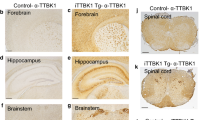Abstract
Coding region and intronic mutations in the tau gene cause frontotemporal dementia and parkinsonism linked to chromosome 17. Some of these mutations lead to an overproduction of tau isoforms with four microtubule-binding repeats. Here we have expressed the longest four-repeat human brain tau isoform in transgenic mice under the control of the murine Thy1 promoter. Transgenic mice aged 3 weeks to 25 months overexpressed human tau protein in nerve cells of brain and spinal cord. Numerous abnormal, tau-immunoreactive nerve cell bodies and dendrites were seen. In addition, large numbers of pathologically enlarged axons containing neurofilament- and tau-immunoreactive spheroids were present, especially in spinal cord. Signs of Wallerian degeneration and neurogenic muscle atrophy were observed. When motor function was tested, transgenic mice showed signs of muscle weakness. Taken together, these findings demonstrate that overexpression of human four-repeat tau leads to a central and peripheral axonopathy that results in nerve cell dysfunction and amyotrophy.
Similar content being viewed by others
Author information
Authors and Affiliations
Additional information
Received: 28 September 1999 / Revised, accepted: 18 November 1999
Rights and permissions
About this article
Cite this article
Probst, A., Götz, J., Wiederhold, K. et al. Axonopathy and amyotrophy in mice transgenic for human four-repeat tau protein. Acta Neuropathol 99, 469–481 (2000). https://doi.org/10.1007/s004010051148
Issue Date:
DOI: https://doi.org/10.1007/s004010051148




